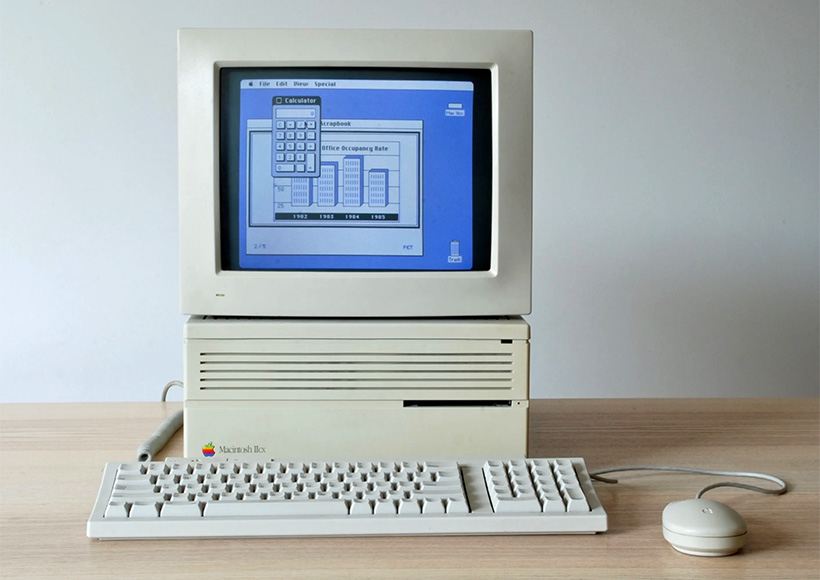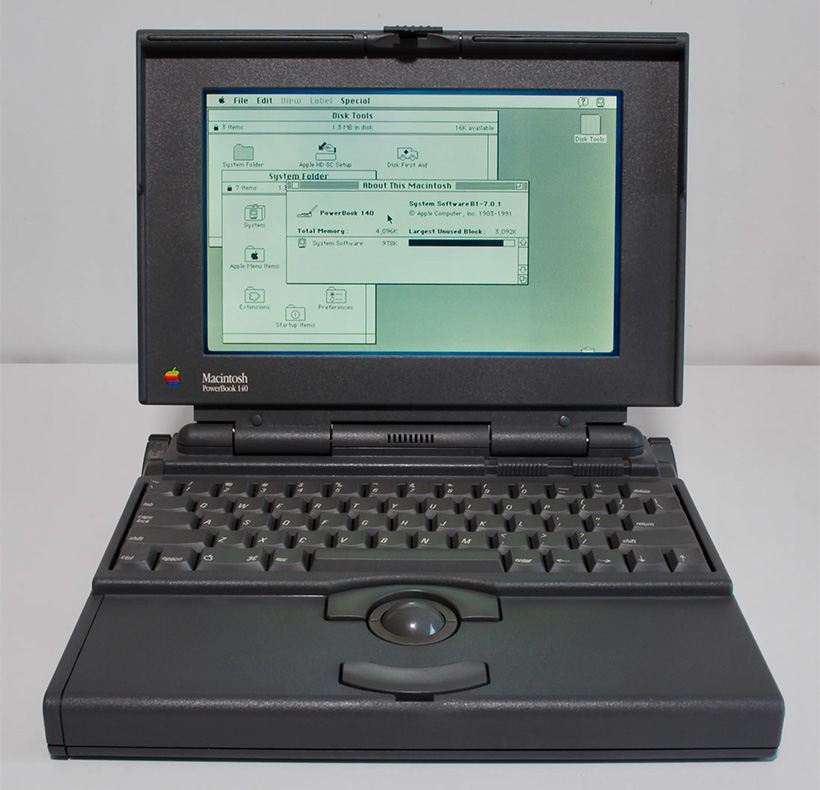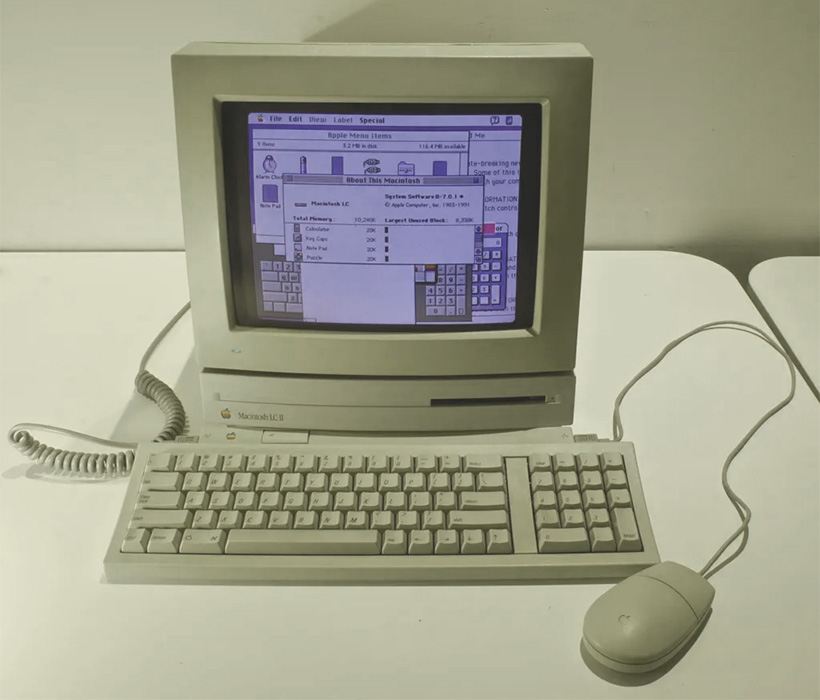History of Apple: 1990-1992 – Most Significant Events
In the eighties, Apple pioneered the personal computing industry in the world with its computer. However, the company then stumbled, and many say it was because of its limited (or closed) approach, based on the high-end computers, while Microsoft (to give an example) flourished through its software designed for low-cost home computers. Apple learned much from those years, and in the nineties it became the wealthy market leader.
Contents
The History of Apple (1976-2016) [Video]
Video uploaded by Nobel Tech on May 2, 2016.
History of Apple: 1990-1992 – Most Significant Events

Apple History 1990
January 1990: Apple discontinues the Macintosh II computer.
March 1990: Apple introduces the Macintosh IIcx at US$9800. The new model features a 40 MHz 68030 processor, 68882 math coprocessor, 4 MB RAM, 80 MB hard drive, 1.4 MB SuperDrive, 32 kB cache, 44.1 kHz stereo audio, and choice of 8-bit to 24-bit graphics.
March 23, 1990: US District Court Judge Vaughn Walker throws out five of six claims in Xerox’ suit against Apple Computer, claiming infringement of the Star’s system.
May 18, 1990: An Apple Macintosh with red diskette appears a few times.
June 1990: Apple Computer announces that Claris shares would not be offered to the public, but that Claris would become a wholly-owned subsidiary of Apple Computer.

Apple History 1991
January 1991: Apple discontinues the Macintosh Portable computer.
February 11 1991: Apple announces introduction of a revised portable computer with backlighting.
March 1991: Apple discontinues the Macintosh IIcx computer.
March 1991: Apple Computer ships first TrueType fonts for the Macintosh.
March 6, 1991: In the lawsuit of Apple Computer versus Microsoft and Hewlett-Packard, Federal District Court Judge Vaughn Walker in San Francisco denies Hewlett-Packard’s request to declare Apple’s copyrights invalid. He also rejects Microsoft’s argument that portions of Windows are covered by the 1985 license from Apple. The judge agrees to Microsoft’s request to consider the copyright issue feature-by-feature, rather than on the basis of overall look and feel. (See also April 1991).
March 18, 1991: In San Francisco, California, the Software Publisher’s Association holds its Spring Symposium, including the Excellence in Software Awards ceremony. Winners include: Lifetime Achievement Award: Steve Wozniak. Best Consumer Program: GeoWorks Ensemble. Best Business Program: Microsoft Windows 3.0.
April 1991: In the lawsuit of Apple Computer versus Microsoft and Hewlett-Packard, Apple broadens its suit to include Windows 3.0. (See also March 6, 1991).
April 12, 1991: Apple Computer’s John Sculley demonstrates to IBM engineers an IBM PS/2 Model 70 running Apple’s Pink object-oriented operating system, appearing to be Apple’s System 7.0 operating system.
May 1991: Apple ships its System 7.0 Macintosh operating system, two years after its announcement, for US$100. New features include drag and drop, networking, file sharing, task switching, document linking, and virtual memory
May 1991: Apple releases the Apple Stylewriter, a modified Canon BubbleJet ink jet printer, using new TrueType font technology.
May 1991: Apple Computer announces QuickTime software, for integration of dynamic media for Macintosh computers.
May 1991: Apple begins distributing test versions of QuickTime to software developers.
July 3, 1991: Apple Computer and IBM sign a technology sharing agreement, to integrate the Mac into IBM’s enterprise systems, to allow future RISC-based Macs to use IBM’s Power PC chip, to work together on common multimedia standards, and to co-operatively produce a new object-oriented operating system. Richard Shaffer, publisher of Computer Letter, comments on the Apple-IBM alliance: It’s like a surfer girl marrying a banker.
August 1991: Steve Jobs agrees with his NeXT company advisers to port the NeXTSTEP operating system to the Intel 80 x 86 architecture.
August 20 1991: Apple Computer and Adobe Systems sign a letter of intent for Apple to include Adobe’s font technology in future System 7 operating system.
August 28, 1991: The first email message is sent from space to Earth, sent by the crew of space shuttle STS-43 Atlantis, using a Macintosh Portable computer and AppleLink software.
September 1991: Apple petitions the FCC to allocate a 40 MHz wide band of frequencies for use with its personal digital assistants.
September 1991: Apple Computer releases the A/UX v2.0 operating system.
October 1991 : At the Microprocessor Forum, Apple Computer outlines its PowerPC migration strategy.
October 1991: Apple Computer and IBM create Kaleida, to create a hardware-independent multimedia scripting language.
October 2, 1991: Apple Computer, Motorola, and IBM sign an accord on technology sharing. Apple and IBM will jointly develop the PowerOpen Specification, based on IBM’s AIX operating system. The Taligent company will be established to develop an operating system based on Apple Computer’s project Pink.
22-26 October 1991: At Fall COMDEX trade show, Apple Computer releases the Macintosh PowerBook 140. The computer features a 16 MHz 68030 CPU, System 7.0.1, 20 MB hard drive, 10-inch supertwist B/W LCD backlit 640 x 400 screen, 2 MB RAM, two expansion slots, SuperDrive floppy drive, weighs 6.8 pounds, and costs US$2899. Apple also releases the Macintosh PowerBook 170. It features a 25 MHz 68030 CPU, System 7.0.1, 40 MB hard drive, 10-inch active matrix B/W LCD backlit 640×400 screen, 4 MB RAM, SuperDrive floppy drive, 2400bps fax/modem, two expansion slots, 68882 math coprocessor, weighs 6.8 pounds, and costs US$4599. Apple introduces the Macintosh Classic II (replacing the Macintosh Classic). It features a 16 MHz 68030, System 7.0.1, 2 MB RAM, 40 MB hard drive, B/W monitor, floppy drive, for US$1899. The company introduces the Macintosh Quadra 700 computer with a 25 MHz 68040, 8-bit (512 kB RAM) or 32-bit (2 MB RAM) color video, System 7.0.1, HyperCard, 4 MB RAM, support for AppleTalk and Ethernet, SuperDrive floppy drive, and various hard drive options, for US$5700-7700.
November 1991: Apple Computer ships QuickTime 1.0, supporting video tracks and soundtracks.
December 31, 1991: Apple announces that up to date the total of 7 million Apple Macintosh computers have been shipped.

Apple History 1992
January 22, 1992: At the first NeXTWORLD Expo, held in San Francisco, Steve Jobs announces that a version of the NeXTSTEP operating system will be made for Intel-based personal computers. Jobs also announces Turbo versions of NeXTstation, NeXTstation Color, NeXTcube with 33-MHz 68040, NEXTSTEP 3.0 OS.
March 1992: Apple Computer introduces the CD150 CD drive, replacing the AppleCD SC Plus.
March 1992: Apple Computer and IBM found Taligent, to work on a platform-independent operating system.
March 1992: Apple Computer announces the Macintosh LC II, replacing the Macintosh LC in the US. The LC II uses a 16 MHz Motorola 68030, and comes with 4 MB RAM, 256 kB video RAM, and a 40 MB hard drive, for US$1700. With 512 kB video RAM, and an 80 MB hard drive, the price is US$2050.
April 1992: Apple Computer releases the A/UX v3.0 operating system. It combines System 7.0 with AT&T’s UNIX System V release 2 version 2, and BSD Unix 4.3 enhancements, and X Window System (X11 2.1.1 and MacX).
April 1992: Apple Computer and Sharp announce an agreement to co-develop a personal digital assistant, based on Apple’s software and Sharp’s hardware.
Mai 1992: Apple Computer introduces the 33 MHz 68040-based Macintosh Quadra 950 (replacing the Quadra 900). It includes 8 MB of RAM, 230/400 MB hard drive options, and 24-bit video supporting 19-inch color monitors. Prices range from US$7200-9200.
July 1992: Apple Computer discontinues the PowerBook 100.
August 1992: Apple Computer announces that the number of users of Apple Computer’s System 7 reaches 4 million.
August 1992: Apple Computer introduces the PowerBook 145, replacing the PowerBook 140. It features a backlit supertwist LCD display, 25 MHz 68030 processor, System 7 operating system, 4 MB RAM, 40 MB hard drive, and weighs 6.8 pounds. Price is US$2149.
September (?) 1992: Apple Computer demonstrates its speech-recognition technology, code-named Casper.
September 1992: Apple Computer releases the Performa 600, the first computer of Performa Line, designed for mass merchandisers and superstores. The Performa 600 has 32 MHz Motorola MC68030 processor, socket for 68882 FPU, three NuBus slots, 160 MB hard drive, accelerator slot, SuperDrive 3.5-inch floppy drive, 4 MB RAM, and 512 kB video RAM.
September 1992: Apple Computer renames the Macintosh LC II the Performa 400.
September 1992: Apple Computer renames the Macintosh Classic II the Performa 200.
September 1992: Apple Computer receives its first PowerPC 601 processor for testing.
October 1992: Apple Computer ships System 7.1 operating system, for the Macintosh.
October 1992: Apple Computer releases an update to QuickTime, adding support for text tracks.
October 1992: Apple Computer begins direct mail order sales.
October 1992: Apple Computer’s Cognac project team first successfully boots up a prototype Power Macintosh using a Power PC 601 processor.
October 1992: Apple Computer introduces and ships the PowerBook 160. It features a 10-inch 16-grayscale backlit supertwist LCD display, 25 MHz 68030 processor, System 7 operating system, 4 MB RAM (expandable to 14 MB), 512 kB video RAM, direct external color monitor port, 40 MB hard drive, SuperDrive floppy drive, and weighs 6.8 pounds. Price is US$2429.
October 1992: Apple Computer introduces and ships the PowerBook 180, replacing the PowerBook 170. It features a 10-inch active-matrix 16-grayscale LCD display, 33 MHz 68030 processor, 68882 math coprocessor, SuperDrive floppy drive, external color monitor port, 4 MB RAM, and 80 MB hard drive. Weight is 6.8 pounds. Price is US$3869.
October 1992: Apple introduces the Macintosh PowerBook Duo systems, consisting of a 4.2-pound portable computer, and a Macintosh Duo Dock desktop docking station.
October 1992: Apple introduces and ships the Macintosh PowerBook Duo 210, featuring a 25 MHz Motorola MC68030 processor, 4 MB RAM, 80 MB hard drive, 640 x 480 grayscale 9.1-inch diagonal supertwist LCD screen, for US$2249. Weight is 4.2 pounds.
October 1992: Apple introduces and ships the Macintosh PowerBook Duo 230, featuring a 33 MHz Motorola MC68030 processor, 4 MB RAM, 80 MB hard drive, 640 x 480 grayscale 9.1-inch diagonal supertwist LCD screen, for US$2609. Weight is 4.2 pounds.
October 1992: Apple introduces and ships the Macintosh IIvx, which is a Macintosh Performa 600 with a 68882 math coprocessor and 32 kB of cache RAM. It features a 33 MHz 68030, 4 MB RAM (upgradeable to 68 MB), 3 NuBus slots, 80 MB hard drive, 512 kB VRAM, optional AppleCD 300i CD-ROM drive, for US$2949.
October 1992: Apple introduces the Macintosh IIvi. It features a 16 MHz 68030, 4 MB RAM, 3 NuBus slots, 40 MB hard drive, System 7.1, for US$2600.
October 1992: One year after the introduction of Apple Computer’s PowerBook, sales of US$1 billion make it the first personal computer to break that threshold. More than 400,000 PowerBooks have been shipped
October 1992: Apple Computer introduces the DuoDock for the PowerBook Duo 210/230 computers. It includes a floppy disk drive, 3.5-inch hard drive bay, two NuBus slots, FPU socket, space for VRAM, and various I/O ports.
November 1992: Apple Computer announces QuickTime for Windows.
November 1992: Top selling Macintosh computer game in the USA is Prince of Persia.
December 4, 1992: Apple executive staff approves proceeding with porting the Mac OS to operate natively on Intel processors.
December 1992: Market share of personal computer shipments in the USA for the year: IBM 10%, Apple Computer 12-13.4%, Compaq 5.6%. Apple shipments of the Macintosh operating system for the year: over 6 million copies.
December 1992: Apple Computer unveils the Macintosh Quadra 900. It features a 25 MHz 68040, 8-bit or 32-bit color video, System 7.0.1, HyperCard, 4 MB RAM, SuperDrive floppy drive, support for AppleTalk or Ethernet, and various hard drive options, for US$7200-9200.
Bibliography
- “iWoz: Computer Geek to Cult Icon: How I Invented the Personal Computer, Co-Founded Apple, and Had Fun Doing It” by Steve Wozniak and Gina Smith
- “Steve Jobs” by Walter Isaacson
Links
- Chronology of Personal Computers
- Apple History
- History of Apple: 1970-1989 – Most Significant Events – iGotOffer Apple Encyclopedia
- History of Apple: 1993–1994 – Most Significant Events – iGotOffer Apple Encyclopedia
- Sell your pre-owned Apple computer online – iGotOffer
- News and Reviews About Electronic Gadgets and Apps – iGotOffer Blog

Thank you, this text helped me to write a thesis about computers history, events in the IT in the beginning of the 90s and how did the change the world.